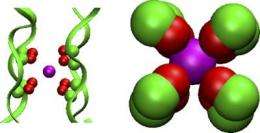New perspectives on ion selectivity

The latest Perspectives in General Physiology series examines the ion selectivity of cation-selective channels and transporters. The series appears in the May 2011 issue of the Journal of General Physiology.
According to Perspectives Editor Olaf Andersen in his introduction, a key tool in most recent studies on ion selectivity has been the so-called "toy models," which emphasize the fluid-like features of the selectivity filter and allow for the isolation of key features. Although proteins may indeed be fluid-like at small-length scales, however, they show considerable rigidity at longer-length scales. Thus, while toy models allow for important new insights, the goal is to transfer this knowledge into understanding the selectivity of the bilayer-spanning channels. This remains a challenge as it becomes necessary to consider not only the equilibrium situations but also the kinetics, and the competition among the permeant ions as they strive to make it through the channel.
As demonstrated by the Perspectives contributors in this issue, the questions surrounding ion selectivity can be approached from different, complementary directions. Alam and Jiang focus on what can be deduced from crystal structures; Nimigean and Allen consider what can be learned from a combined electrophysiological, crystallographic, and computational approach; and the last three contributors—Roux et al., Dixit and Asthagiri, and Varma et al. (appearing in the June 2011 issue of the JGP)—consider different theoretical and computational approaches based on MD simulations and quasi-chemical theory, including the use of simple "toy" models, to identify the mechanisms underlying ion selectivity.
More information:
Andersen, O.S. 2011. J. Gen. Physiol. doi:10.1085/jgp.201110651
Alam, A., and Y. Jiang. 2011. J. Gen. Physiol. doi:10.1085/jgp.201010546
Nimigean, C.M., and T.W. Allen. 2011. J. Gen. Physiol. doi:10.1085/jgp.201010551
Roux, B., et al. 2011. J. Gen. Physiol. doi:10.1085/jgp.201010577
Dixit, P.D., and D. Asthagiri. 2011. J. Gen. Physiol. doi:10.1085/jgp.201010533

















